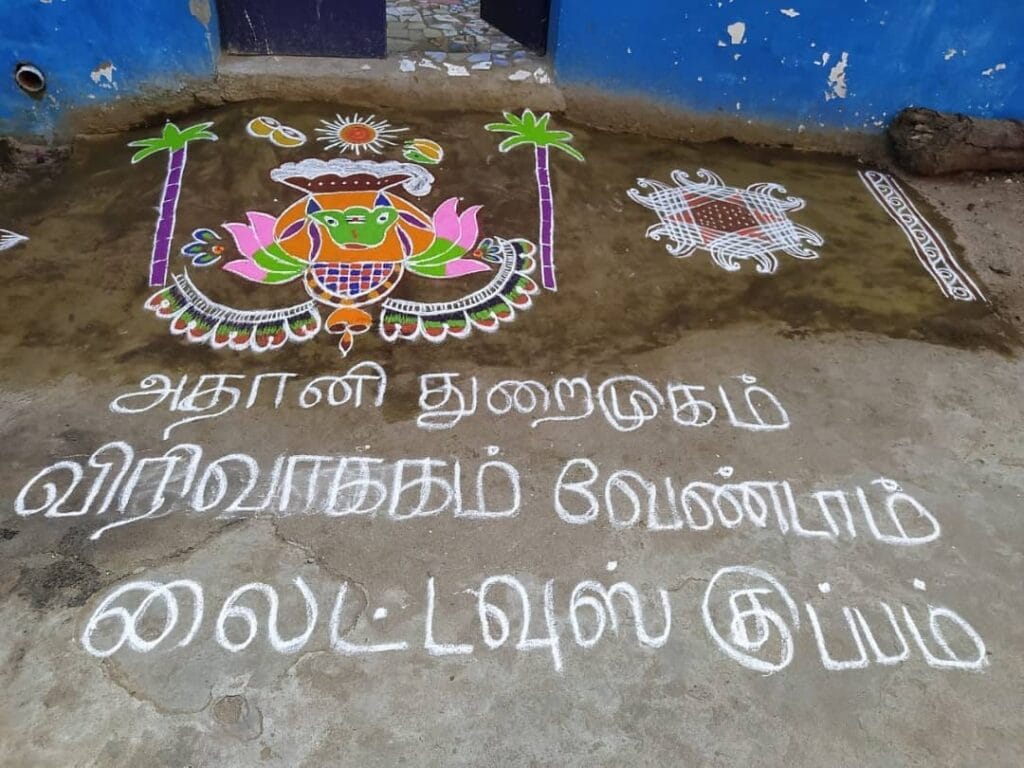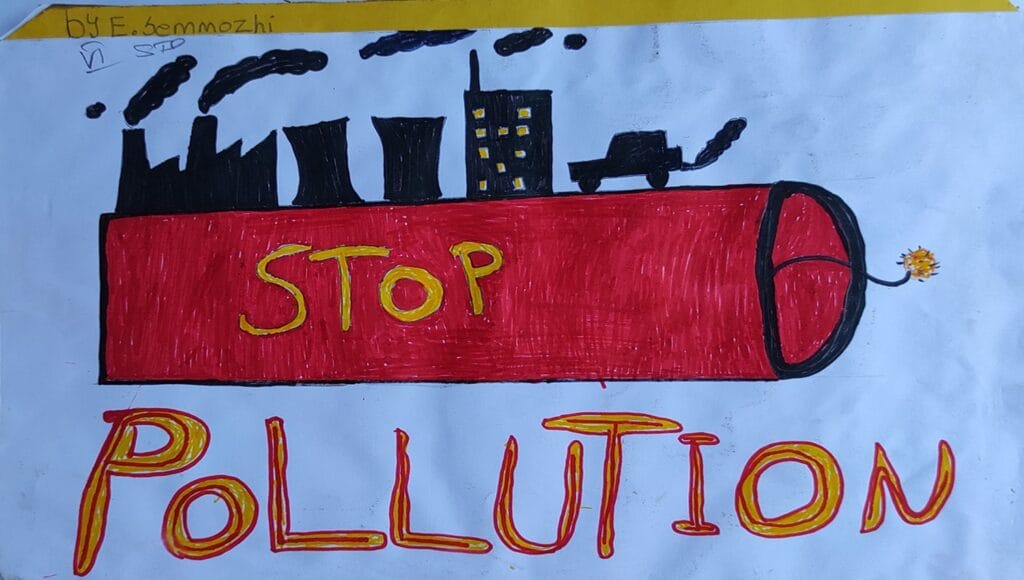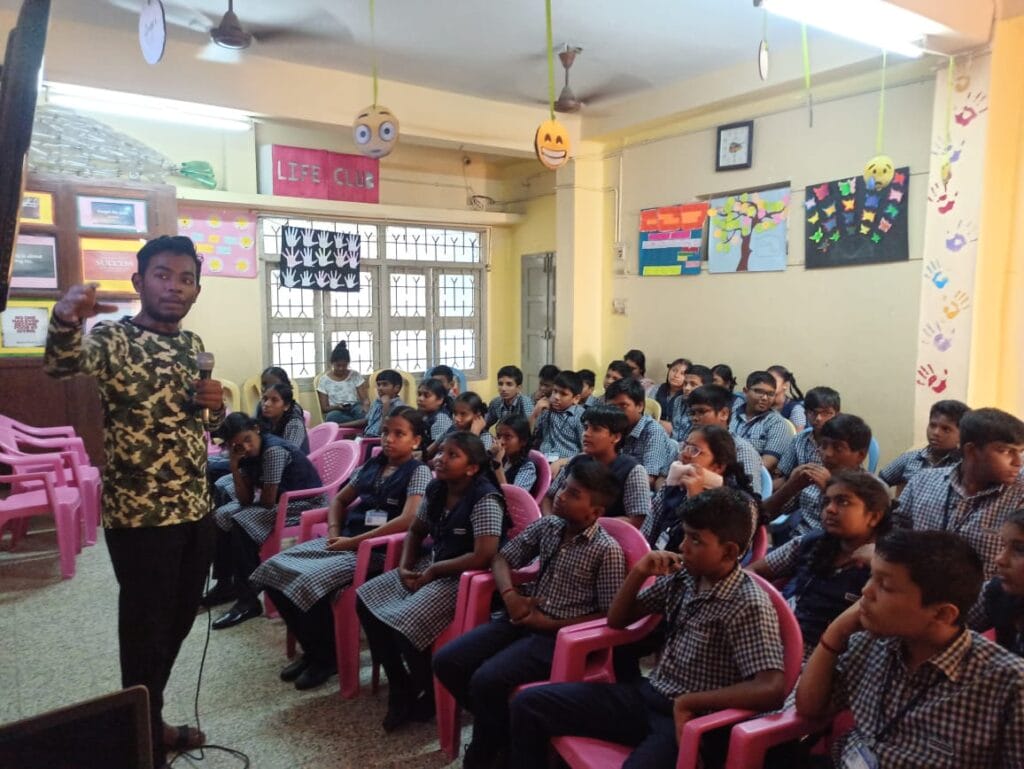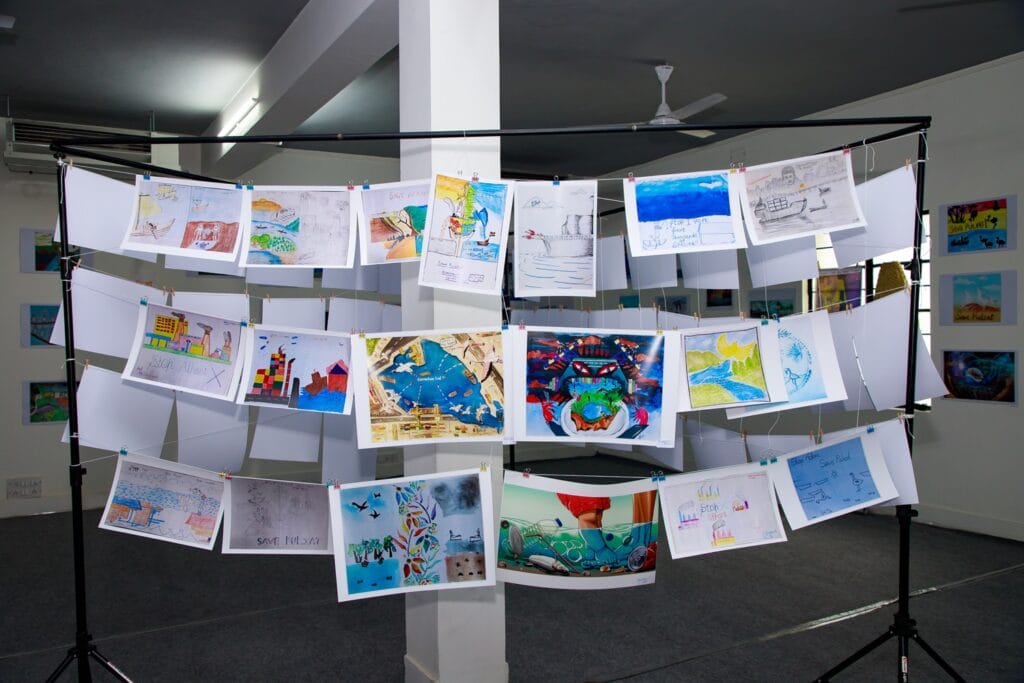People of North Chennai have been vocal about the adverse effects of pollution that taints the air, land and water in their area. They are often seen staging protests against projects that may have a negative bearing on the lives and livelihoods of the people and the environment. Several studies have reiterated that major industries operating in the Ennore-Manali region, including the state-owned thermal power plant, contribute to the rising pollution in North Chennai. It is the residents who bear the brunt of this toxic onslaught — as they breathe poisonous air every day and use water that is highly contaminated with industrial effluents.
Usually, the North Chennaiites register their dissent in the form of black flag protests or road roko campaigns. But lately, armed with knowledge of the legal aspects and environmental impact of pollution, the community has devised unique methods to make themselves seen and heard.
Here’s an example: while protesting the construction of power transmission towers inside the Kosasthalaiyar River on July 26, inland fishers from North Chennai had no black flags or loud slogans. They surrounded the construction site in their boats with piles of papers and maps as proof that the transmission tower was illegally erected inside the river. They demanded that the government give their river back to them.
The efforts of various groups like Chennai Climate Action Group (CCAG), Vettiver Collective, Palluyir Trust and others that are part of Climate Action Collective, play a major role in educating the community and equipping them with crucial information. Using different forms of art; employing creative means such as making kolam; organising food festivals and involving children to take a stand—these are some of the innovative expressions of dissent by North Chennai residents.
Read more: Industrial pollution in Chennai: Through the lens of the toxic tour
Food festival against Adani mega port project in North Chennai
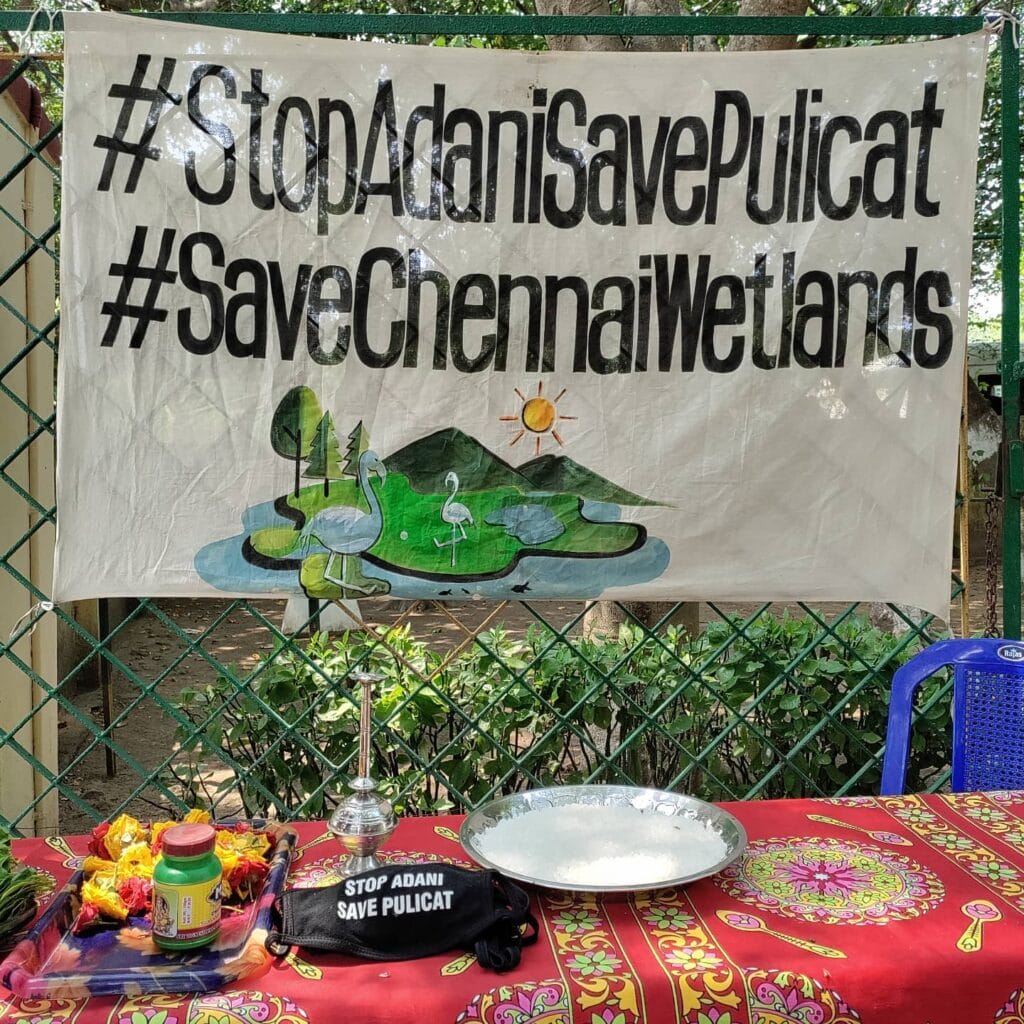
In January 2021, the public hearing of the Adani port expansion was announced. The fisher community deems this project a threat to the lives, livelihoods and living spaces in the North Chennai region. That’s because the area between the sea and the Pazhaverkadu lagoon, which is blessed with year-round availability of fish, is at threat from this project. The fishers explain that the best fishing grounds to find a large amount of fish are in places where the ocean floor has paar (rocks/reefs) or seru (mud).
The portion of the sea where the said port is proposed has six such fishing zones (seru pagudhi—where the ocean floor is muddy). Fish varieties like kanankeluthi, mulima, panna, kala, kadal kazhangan, udupathi, navarai, sankara, semakkera, vellra and kadal nandu usually populate these areas. The project aims to convert the near-shore area into land by dumping earth into the sea. This will not only affect the ecosystem but also the livelihood of fishers in the region.
Moreover, the DMK had made a poll promise to oppose the project during the Assembly polls. To remind the government of the promise, the women of Pazhaverkadu along with Vettiver Collective organised a ‘Traditional Tamil Seafood Feast’ on October 16, 2021. The women in the region not only cook fish but also contribute to the fisheries economy of the region. They play a major role from catching fish to auctioning and marketing them. The feast had the traditional recipes prepared using seasonal fish and the hand-me-down wisdom of their ancestors.
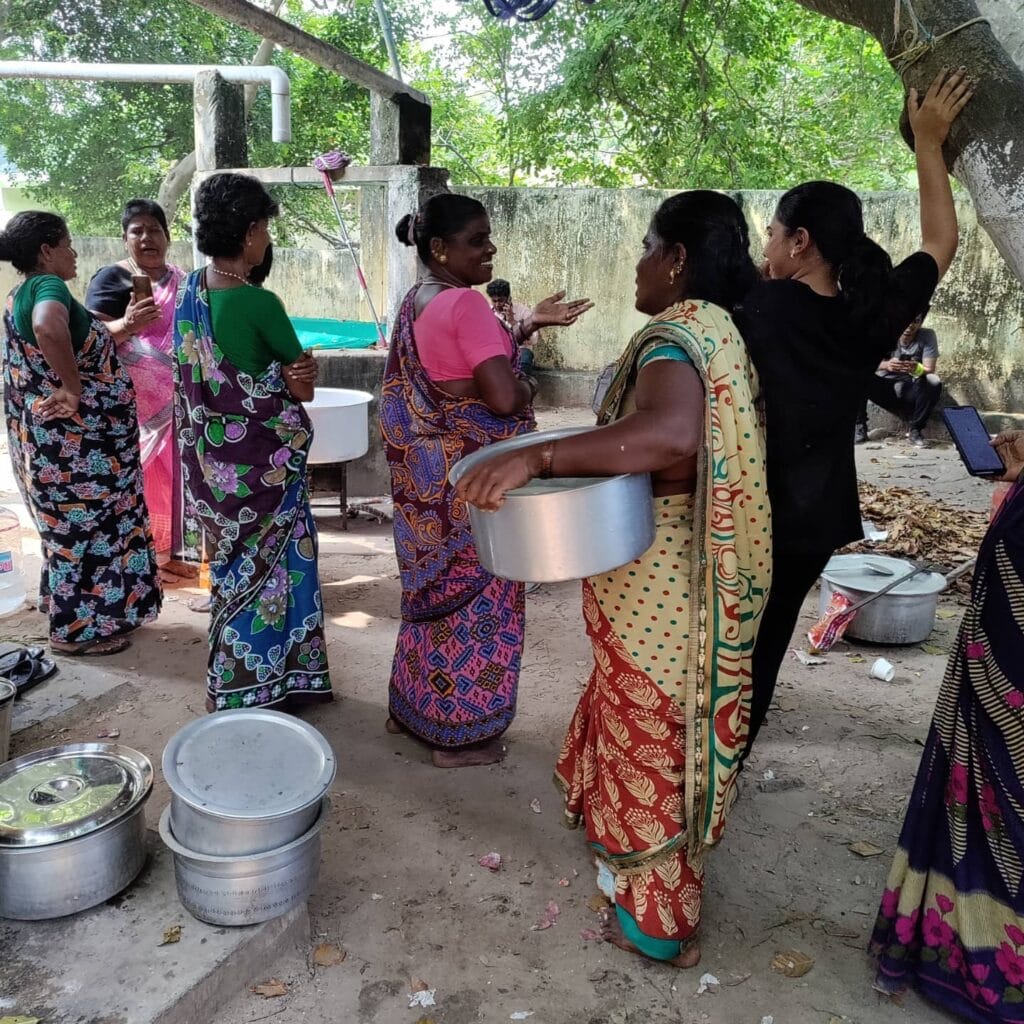
The invitation for this feast extended to Chief Minister MK Stalin, reads, “We do not wish to speak about the dangers of the proposed project through the invitation for a feast. Rather, we wish you to come to our village to taste the food to understand the correctness of your promises to cancel the port.”
This food festival saw a huge footfall, including elected representatives from in and around Chennai, who expressed their solidarity with the people of the region against the Adani port expansion project.
Read more: These six industries in North Chennai are polluting the air for more than half the year
Kolam, a mode to express dissent
Kolam (line drawing made on the floor, in front of homes) is a key element in most of our households. We all have a memory of doing these drawings with colours in front of our homes during the festivities. However, a few North Chennai citizens used kolam as a medium to show their opposition to the Adani port expansion project, Environmental Impact Assessment (EIA), 2020 draft and the Ennore Thermal Power Station (ETPS) expansion.
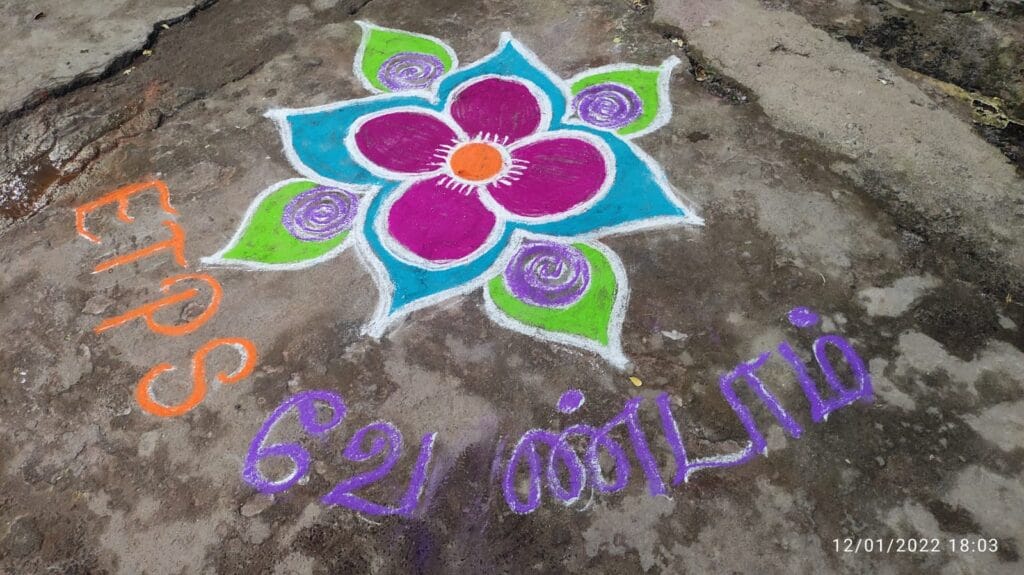
The fishers explain that the expansion of the ETPS will only add to the existing pollution. Similarly, the Union Environment Ministry introduced more than 30 amending notes in the draft EIA, 2020 that diluted the provisions of the EIA notification. Notably, the draft was published amidst the nationwide lockdown during the COVID-19 pandemic when the people were still grappling with its impact on their livelihoods and health.
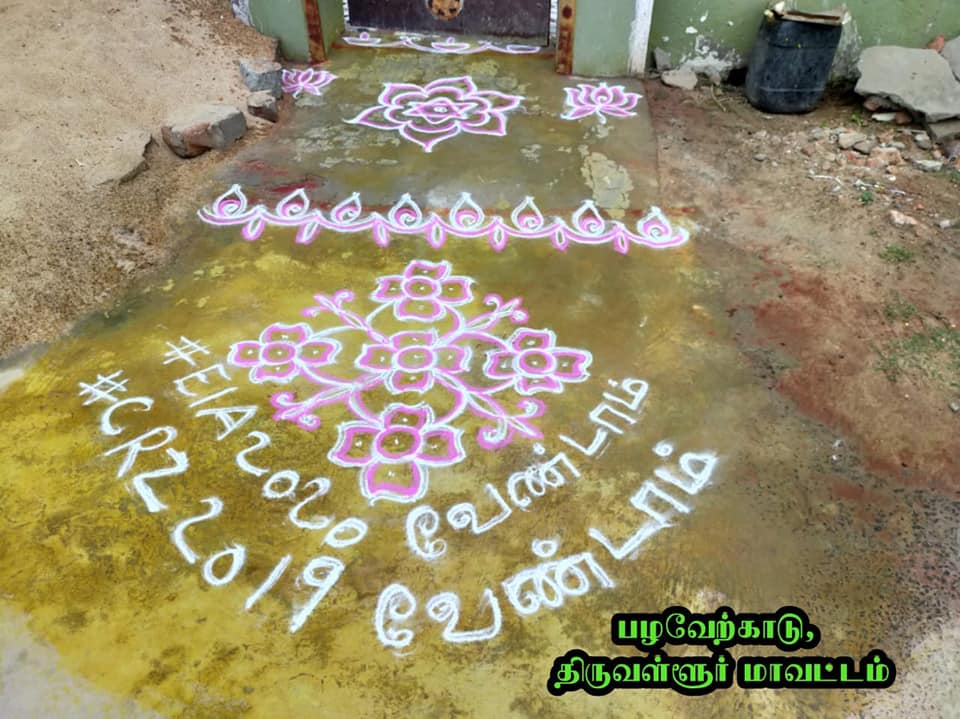
Benisha, a volunteer with CCAG, says there have been three kolam protests so far, organised with the help of Vettiver Collective. “Though the people of the whole city were supposed to participate in this protest, it was predominantly done by North Chennai residents. This protest was part of a larger campaign against these industrial projects. The photos of the kolams that had slogans against the projects were used for social media campaigns,” she says.
Involving children in art campaigns against polluting industries
Explaining the need to educate children on pertinent issues in their community, Benisha says, “When we interact with children on environmental issues, we find that they look forward to a pollution-free future. We need to give the platform for the children to come out and express their thoughts on these issues because it is their future at stake.”
The Climate Action Collective conducted several workshops for children, especially in schools in and around North Chennai, to make them aware of the dangers of projects like the ETPS and Adani port expansion. Then, the children took part in an art campaign to express their thoughts on the issue.
A compilation of artwork by children (and other young artists across the world ) titled “Painting Art to Power: The Growing Social Movement against Adani” was also featured on the Adani Watch website.
“Drawing/painting is a medium that the children will prefer over other art forms. It helps them make creative observations on the adverse impact of rampant industrialisation in their daily life,” says Benisha.
“Youngsters are aware of the discourse on climate change and want to know more. Through our sessions, we help them understand the ground reality which is in contradiction with the corporate narrative that they have consumed on climate change. We also need to equip the children to ask questions about all developments that will affect their future. This is the intention of involving students/children in the art campaigns,” she adds.
Music, yet another form of showing dissent
North Chennai is not only the birthplace of gaana or a melting pot of cultures and cuisines, but also home to Chennai’s best athletes, kabaddi players and boxers. Over the period, the poor air quality in the region started taking a toll on the health of the residents. Eventually, the breathing capacity of the residents, including the athletes here has been affected tremendously due to pollution. Using these observations and anecdotal experiences of the people in North Chennai, a song called Kaatha vara vidu was launched by Vettiver Collective.
Similarly, a video series titled ‘Poisoned Playgrounds’ was also launched by Vettiver Collective depicting the impact of industrial pollution on the children in the region. This video series had three videos – Seppakkam (Thala Thala Bhoomi), Seppakkam (Toxic Puddle) and Swimming in Ash (Kattukuppam, Ennore).
Reframing North Chennai through the lens of residents
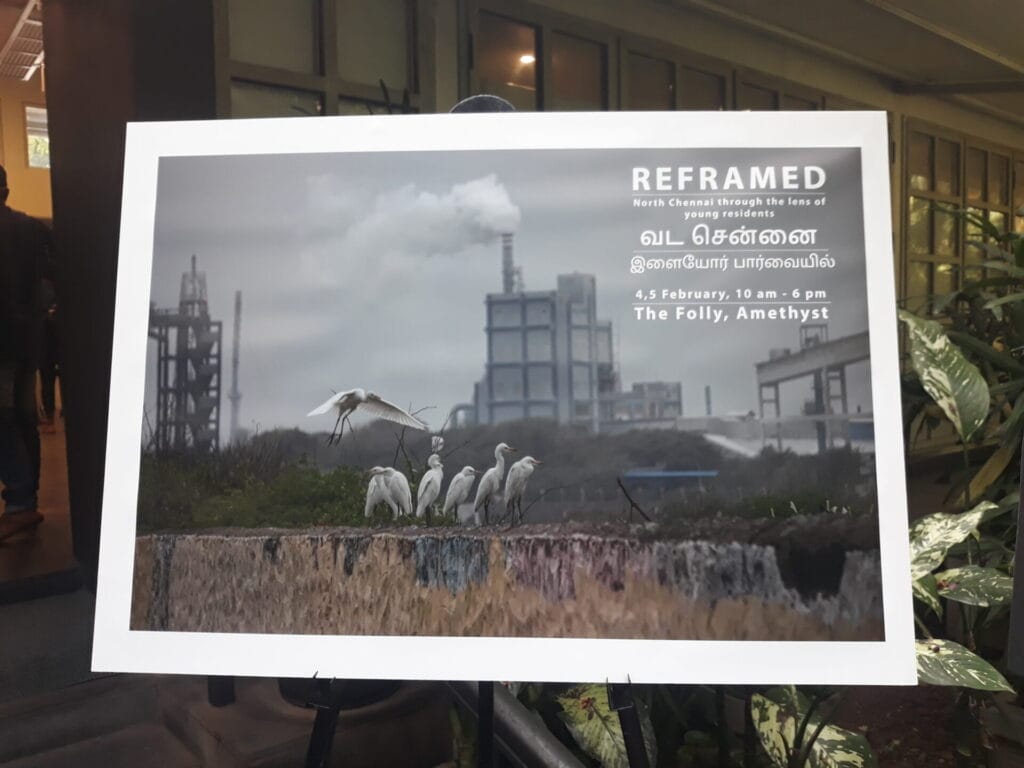
Photography is another medium of dissent for the people of this region. In an attempt to highlight their stories about work, play, joy and mourning in North Chennai through the lens of the residents, Palani Kumar, a photojournalist, trained six young residents, including a 21-year-old and five children in the 14–17 age group.

These six young residents held a digital camera for the first time in their lives in July 2021. From the thousands of photos they shot, 50 were selected and showcased in a photo exhibition titled ‘North Chennai REFRAMED’ on February 4, 2022. REFRAMED was a collaborative effort of Coastal Resource Centre, Chennai Climate Action Group and Zenith Learning Centre. This photo series was also taken to multiple other platforms. These youngsters continue to document various social issues in and around Chennai using the photos as their medium to express their dissent.
While it is important to bring out the stories from the people of North Chennai, it is equally important to take these stories to the people in other parts of the city. Following the recent announcement on the public hearing for the Kattupalli Adani Mega Port in September this year, CCAG along with Palluyir Trust organised an art exhibition on September 8 and 9 — ‘Strokes of Solidarity’ against the Kattupalli project, which directly and indirectly affects of people and biodiversity in Chennai and Tiruvallur district.
The exhibition displayed hundreds of paintings by youth and children and various documentary screenings, panel discussions, music and story-telling sessions were held to educate the public. The exhibition was so well-curated that Members of Parliament (MP) Thol Thirumavalavan and North Chennai MP Thiru Kalanidhi Veeraswamy spent at least an hour to understand the issue. As a positive outcome of the art exhibition, these elected representatives also issued a statement that they would oppose the project at all costs.
“The people of North Chennai have been opposing the project and protesting against it for a long time. It is important to keep this dialogue active among the people in South Chennai as well. This is important because, when the environment of North Chennai gets affected, eventually it will affect the people in the South and other parts of Chennai as well. This was the intention behind the art exhibition,” says Benisha.
The air we breathe is common to all, so it is not long before the toxic effects of the polluting industries will be seen well beyond North Chennai. That is the message the community here is trying to propagate.
